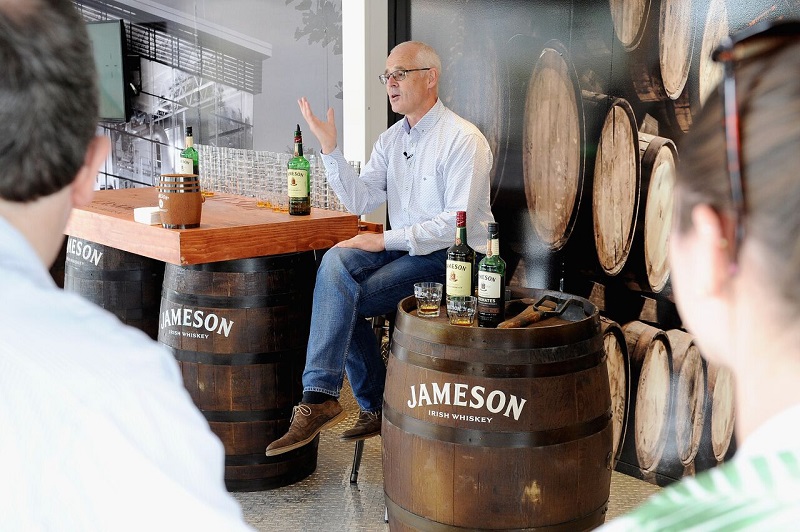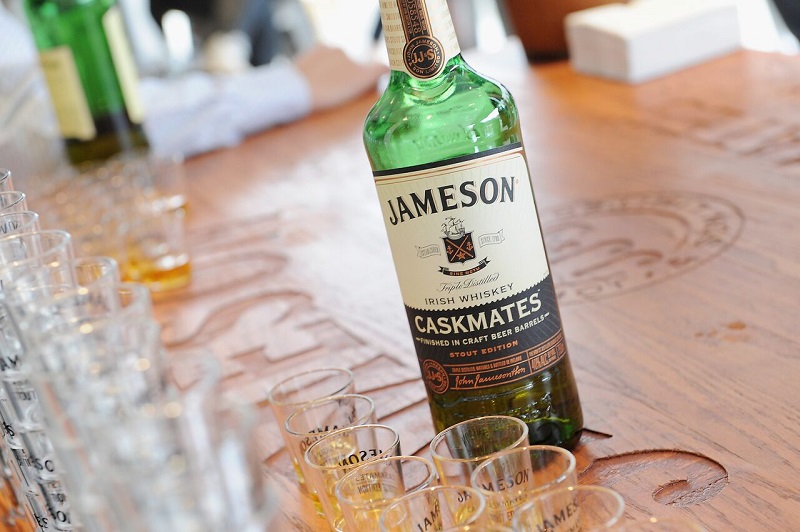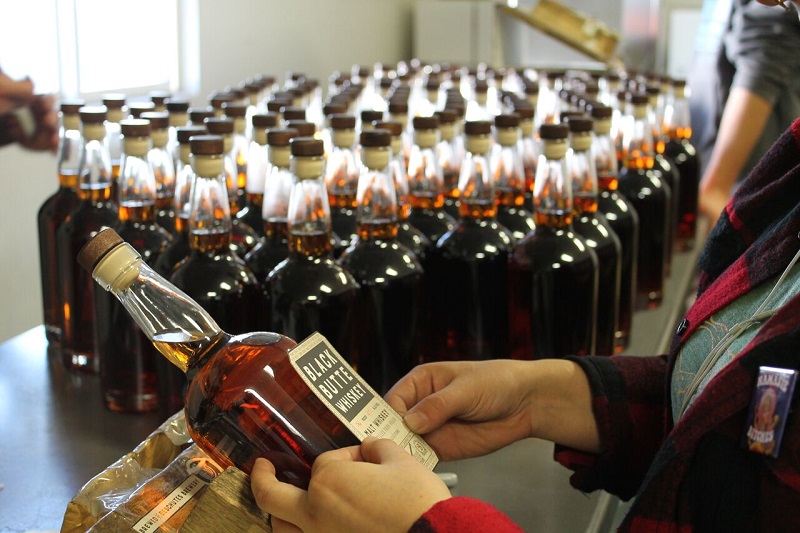Full Circle: Breweries and Distilleries Share Barrels
Today's beer and spirit makers find common ground in their ingredients, processes and consumers.

Dave Quinn speaks at Jameson Irish Whiskey’s Love Thy Neighbor event in Brooklyn last October. (Photo by Craig Barritt/Getty Images, courtesy Jameson Irish Whiskey)
Last October, at Jameson Irish Whiskey’s Love Thy Neighbor festival, a small collection of brewers coalesced in the Duggal Greenhouse located on Brooklyn’s waterfront. Outside, Dave Quinn, the head of whiskey science at Jameson, guided patrons through the production (and thematic pairings) of the event’s focus—stout-barrel-aged Jameson Caskmates whiskey. Inside, brewers showcased specialty Jameson barrel-aged beers alongside standard offerings, as drifting patrons snacked on pretzel necklaces, bánh mì-inspired fried chicken sliders and lettuce wraps to the tune of live music and falling jumbo Jenga stacks.
“You’re either going to make some memories or lose some,” says one festival-goer.
As a prominent and popular debut for Jameson’s new Caskmates whiskey, the event spoke to an increasingly intimate relationship between spirits and beer. Coming on the heels of programs from Rogue Ales and Spirits, New Holland Brewing, Anchor Brewing Co., Deschutes Brewery and many others, Jameson’s move to tie its brand to the craft beer industry isn’t novel. It is, however, notable due to the distillery’s status as an international player.

(Photo by Craig Barritt/Getty Images, courtesy Jameson Irish Whiskey)
What Jameson’s Caskmates represents, instead, is how much consumer awareness and interest has expanded relating to the coming together of beer and whiskey—an expansion that can be seen, too, in the recent rollout of Goose Island’s collaboration “Bierschnaps” (aged in former Bourbon County Barrels) with Rhine Hall Distillery in Chicago, as well as in the unveiling of Two Lanterns Whiskey, which is distilled from Samuel Adams Boston Lager by Berkshire Mountain Distillers.
“Every whiskey, at its core, is basically distilled beer,” says Alan Dietrich, the chief executive officer of Bendistillery, which partners with Deschutes Brewery to make Black Butte Whiskey from the mash of the brewery’s signature porter. “Just like brandy is distilled wine, and vodka and gin are distilled grains, whiskey is a distilled malt beverage.”
Highlighting the Connection Between Beer and Spirits
New Holland Brewing and Artisan Spirits anticipated consumer interest when it first released its Beer Barrel Bourbon in 2012. Inspired by the flavor variations and nuance of Scotch aged in barrels that formerly held sherry, New Holland president Brett VanderKamp decided to age the distillery’s whiskeys in barrels that once held the brewery’s Dragon’s Milk stout.
“The brand [Beer Barrel Bourbon] came out in 2012,” wrote Layne Keuning, marketing coordinator for New Holland.
“The first year we sold about 500 nine-liter cases [of the Bourbon] and this year we will be closer to 7,500 nine-liter cases.” Next year, she adds, New Holland anticipates sales closer to 10,000 cases.
New Holland’s Beer Barrel Bourbon is intimately related to its frothier brethren in multiple ways. The malt bill has an uncharacteristically high barley content, though it still meets the necessary grain requirements to be legally classified as a bourbon (which is to say corn constitutes at least 51 percent of the mash). And while not all Dragon’s Milk batches are aged in New Holland’s used whiskey barrels due to scale—there are five barrels in the Dragon’s Milk program for every one barrel in the Beer Barrel whiskey program—all Beer Barrel Bourbon is aged in barrels that housed Dragon’s Milk and then blended, like Dragon’s Milk, for consistency.
“It adds a layer of complexity, it adds more mouthfeel, and it kind of just smooths some of the rougher parts of the bourbon off,” explains VanderKamp. Joel Armato, retail beverage specialist at New Holland, adds that subtle notes of vanilla and cocoa and sweetness carry from the stout to the whiskey, too.
Dave Quinn, the head of whiskey science at Jameson, detailed similar effects of the beer barrel-aging process throughout his educational seminars at Love Thy Neighbor.
“The new whiskey combines the triple distilled smoothness of Jameson Original with the richness of stout beer, adding notes of coffee, cocoa and hops for a truly unique finish,” he wrote in an email following the event. Following last year’s stout-barrel-aged whiskey, Jameson also released a Caskmates whiskey aged in barrels that once held IPA.
To both capitalize upon and promote this heightened consumer engagement, New Holland offers and even encourages customers to try Dragon’s Milk and Beer Barrel whiskey side-by-side to discover the products’ singularities and similarities in its taprooms.

The distillery at New Holland Brewing and Artisan Spirits (Photo courtesy New Holland Brewing and Artisan Spirits)
At those taprooms, patrons can try the whiskey as samples or small pours alongside beers like Dragon’s Milk, or they can order the spirit on its own, as part of flights, and in cocktails such as The Dude, which combines the Beer Barrel Bourbon with a Dragon’s Milk reduction, chocolate bitters and cream, and the Beer Drinkers’ Old Fashioned, which substitutes that same beer reduction in place of simple syrup and uses chocolate bitters alongside more traditional orange ones.
“For us, it’s taken a minute to really find the ways to highlight the brands like Beer Barrel Bourbon and get them in front of people in a variety of ways that capture their attention,” says Armato. “We realized the value of a sample and how far a sample can go for someone.”
To many, the experience of beer and whiskey together—a shot and a beer, a boilermaker, or “hauf-an-hauf”—has long been associated with an efficient if perhaps lowbrow experience of alcohol delivery. But, similar to the theme of the Jameson event, New Holland’s idea of that experience is something slower, a moment of drawing connections in flavors and processes from one beverage to the next.
“There’s a little bit more thoughtfulness that comes with that order,” says Armato. “And that’s a big reason why it’s a bit of a slower, sip and enjoyment kind of thing, rather than crush a beer and throw the shot back.”
Following Armato’s instruction, I simulated the experience at home using a pour of Beer Barrel Bourbon and a six-ounce pour of Dragon’s Milk. Starting with the beer, then transitioning to sips of the whiskey, I could clearly follow notes of cocoa and vanilla from one beverage to the next, though the other flavors of nuts and dark fruit carried over in a more subtle presence, too, subdued beneath the boozy punch of the whiskey. Texturally, it felt like a layered coating of the tongue in a single palette of flavors that altered in volume and emphasis. And, perhaps dangerously, the alternation made my consumption of each far easier by creating balancing refuges of heat and sweet richness.
“Warming your palate up to all of the flavors that are in that beer are important, and finding all the nuances that are in that bourbon as well,” Armato adds.
The Rise of Beer-Barrel-Aged Whiskies
The economics of shared ingredients and processes fosters a natural relationship between beer and whiskey. It can make it easier to work with local breweries, as it has for Oliver Mulligan, founder of Great Wagon Road Distilling Co. in Charlotte, North Carolina. His neighbors at The Olde Mecklenburg Brewery handle his mash production, which saved him from purchasing the necessary equipment. Instead, he lets the brewery handle the mash, which is then trucked just a few hundred feet over to Great Wagon Road to be distilled.
“We do all the mashes for Great Wagon Road, and then we pass them off to them and they ferment everything,” says Jocelyn Ruark, marketing manager for The Olde Mecklenburg Brewery. “They put it into the barrels to age, and once that’s done aging, they give us the barrels back and we age our barrel-aged brews in those barrels.”
Mulligan’s Rua whiskey uses 100 percent malted barley—a principal ingredient in beer. Though it once used an identical mash bill to Olde Meck’s Fat Boy Baltic Porter, Mulligan has since adjusted his recipe to use only pilsner malt. Those early batches made with the Fat Boy mash, according to Ruark, were “deeper […] all the flavors times two.”
“When you taste the Rua you get to taste that beautiful char from the barrels, the caramel that comes out of the oak, that nice little barley note and a light chocolate finish,” Mulligan says. Darker specialty malts, he explains, overpowered those more subtle flavors.
Dietrich, of Bendistillery, sees that kind of evaluation as beside the point, however. When it comes to beer-barrel-aged whiskeys, he sees them rather as an entirely separate and new product, “a uniquely American malt whiskey” with its own characteristics distinct from standard ryes or bourbons.
“I’ll tell you, we did not have any preconceived notions about what we wanted the finished product to be, other than that we wanted it to taste great,” says Dietrich.
“We have numerous plans as the volumes grow to experiment with finishing the product in used barrels, letting the product age longer […] really it’s a making-it-up-as-we-go-situation,” he continues. “We are constantly tasting the product, and discussing with Deschutes what we want to do.”

(Photo courtesy Deschutes Brewery)
New Holland recently rolled out a Beer Barrel Rye to expand from its Beer Barrel Bourbon, and Mulligan is currently aging Rua on barrels that previously held barrel-aged Fat Boy. Though the casks were originally going to be converted into furniture, Mulligan says the barrels “smelled so good there was no way I wasn’t putting whiskey in them.”
Bendistillery and Deschutes, in the meanwhile, are aging a collaboration Abyss whiskey, though on a timeline beer drinkers probably aren’t accustomed to.
“I can confidently tell you the Abyss will come out within the next 2-10 years,” says Dietrich with a laugh. “We’re making whiskey man, you don’t know when you’re going to get something until you get it.”
Bo McMillan is the former editorial assistant for All About Beer Magazine, and is currently pursuing his PhD in English and Comparative Literature at Columbia University.

I hope that my state liquor agency will bring these to Ohio soon.
They have been opening up to more variety like this for the last year.